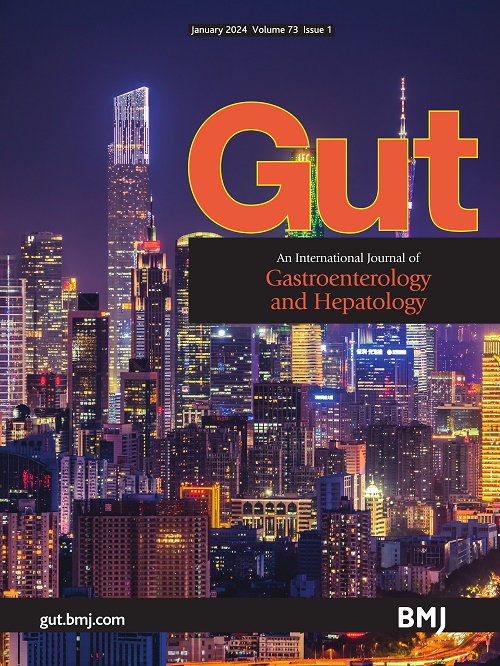血糖控制是糖尿病患者胰腺癌发展的一个可改变的危险因素:一项基于人群的队列研究
IF 25.8
1区 医学
Q1 GASTROENTEROLOGY & HEPATOLOGY
引用次数: 0
摘要
背景:血糖控制对长期2型糖尿病(T2D)患者胰腺癌(PC)发展的影响尚不清楚。目的探讨血糖控制对t2dm患者PC发展的影响。设计回顾性队列研究。方法:从T2D诊断到PC、死亡、胰腺切除术或研究结束(2020年12月),对来自全国卫生保健登记处的成年人进行随访。排除T2D诊断后3年内的PC(解决反向因果关系),既往PC,免疫球蛋白G4疾病和胰腺切除术。主要结局是PC,次要结局包括PC相关死亡率和全因死亡率。在整个随访过程中,最佳血糖控制定义为:时间加权平均血红蛋白A1c <7%;以时间加权平均空腹血糖(FG)≤7 mmol/L为次要分析。校正HR (aHR)使用Cox模型估计,并对包括人口统计学、糖尿病并发症、合并症和药物在内的协变量进行倾向评分调整。结果458331例患者中位年龄59.8岁(P25-P75: 51.8-68.5岁);在中位随访9.9年(P25-P75: 7.4-14.1)期间,有1382例(0.3%;2.8 / 10000人年)PC相关死亡,922例(0.2%;1.9 / 10000人年)PC相关死亡,70936例(15.5%;142.9 / 10000人年)死亡。最佳血糖控制与降低PC风险- a1c <7%(aHR: 0.43; 95% CI: 0.37至0.48)和FG≤7 mmol/L (aHR: 0.71; 95% CI: 0.63至0.80)相关。A1c和FG的最佳控制使PC风险最低(aHR: 0.39; 95% CI: 0.33 ~ 0.46)。随着A1c的增加,PC风险逐渐增加(Ptrend<0.001), ahr从1.85 (A1c 7.0-7.5%)增加到4.61 (A1c≥9.0%)。糖化血红蛋白每升高1%,空腹血糖每升高1 mmol/L,患PC的风险分别增加46%和14%。最佳控制还与较低的pc相关死亡率(aHR: 0.35; 95% CI: 0.30至0.41)和全因死亡率(aHR: 0.83; 95% CI: 0.82至0.85)相关。结论最佳血糖控制与t2dm患者较低的PC风险相关。需要进一步的多中心队列研究来证实其预防策略。本文章由计算机程序翻译,如有差异,请以英文原文为准。
Glycaemic control is a modifiable risk factor for pancreatic cancer development in patients with diabetes: a population-based cohort study.
BACKGROUND
Effect of glycaemic control on pancreatic cancer (PC) development in patients with long-standing type 2 diabetes (T2D) remains unclear.
OBJECTIVE
To investigate effects of glycaemic control on PC development in patients with T2D.
DESIGN
Retrospective cohort study.
METHODS
Adults from a territory-wide healthcare registry were followed from T2D diagnosis until PC, death, pancreatectomy or end of study (December 2020). Exclusions were PC within 3 years after T2D diagnosis (addressing reverse causality), prior PC, immunoglobulin G4 disease and pancreatectomy. The primary outcome was PC and secondary outcomes included PC-related and all-cause mortality. Optimal glycaemic control throughout follow-up was defined as time-weighted mean haemoglobin A1c (A1c)<7%; with time-weighted mean fasting glucose (FG)≤7 mmol/L as secondary analysis. Adjusted HR (aHR) was estimated using Cox models with propensity score adjustment for covariates including demographics, diabetes complications, comorbidities and medications.
RESULTS
Among 458 331 patients (median age: 59.8 (P25-P75: 51.8-68.5) years; 51.2% male), there were 1382 (0.3%; 2.8 per 10 000 person-years) PC, 922 (0.2%; 1.9 per 10 000 person-years) PC-related deaths, and 70 936 (15.5%; 142.9 per 10 000 person-years) deaths over a median follow-up of 9.9 (P25-P75: 7.4-14.1) years. Optimal glycaemic control was associated with lower PC risk-A1c<7%(aHR: 0.43; 95% CI: 0.37 to 0.48) and FG≤7 mmol/L (aHR: 0.71; 95% CI: 0.63 to 0.80). Optimal control of both A1c and FG conferred lowest PC risk (aHR: 0.39; 95% CI: 0.33 to 0.46). PC risk increased stepwise with A1c (Ptrend<0.001), with aHRs from 1.85 (A1c 7.0-7.5%) to 4.61 (A1c≥9.0%). Every 1% rise in A1c and 1 mmol/L rise in FG increased PC risk by 46% and 14%, respectively. Optimal control is also associated with lower PC-related mortality (aHR: 0.35; 95% CI: 0.30 to 0.41) and all-cause mortality (aHR: 0.83; 95% CI: 0.82 to 0.85).
CONCLUSION
Optimal glycaemic control was associated with lower PC risk in T2D. Further multicentre cohort studies are warranted to confirm its oncopreventive strategy.
求助全文
通过发布文献求助,成功后即可免费获取论文全文。
去求助
来源期刊

Gut
医学-胃肠肝病学
CiteScore
45.70
自引率
2.40%
发文量
284
审稿时长
1.5 months
期刊介绍:
Gut is a renowned international journal specializing in gastroenterology and hepatology, known for its high-quality clinical research covering the alimentary tract, liver, biliary tree, and pancreas. It offers authoritative and current coverage across all aspects of gastroenterology and hepatology, featuring articles on emerging disease mechanisms and innovative diagnostic and therapeutic approaches authored by leading experts.
As the flagship journal of BMJ's gastroenterology portfolio, Gut is accompanied by two companion journals: Frontline Gastroenterology, focusing on education and practice-oriented papers, and BMJ Open Gastroenterology for open access original research.
 求助内容:
求助内容: 应助结果提醒方式:
应助结果提醒方式:


